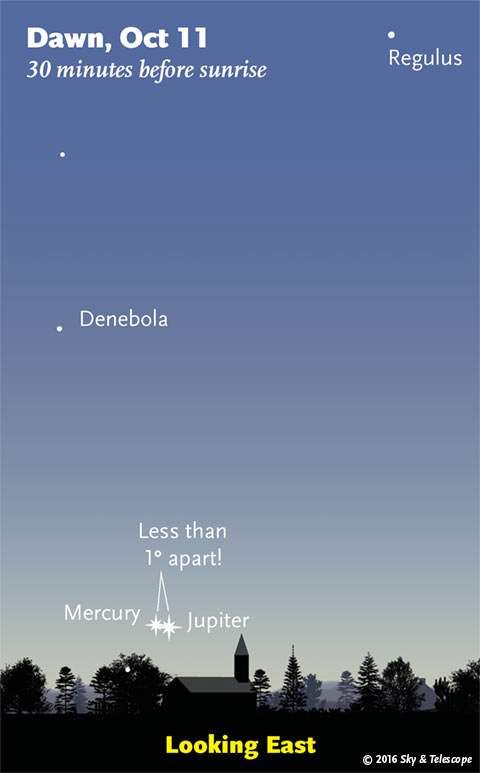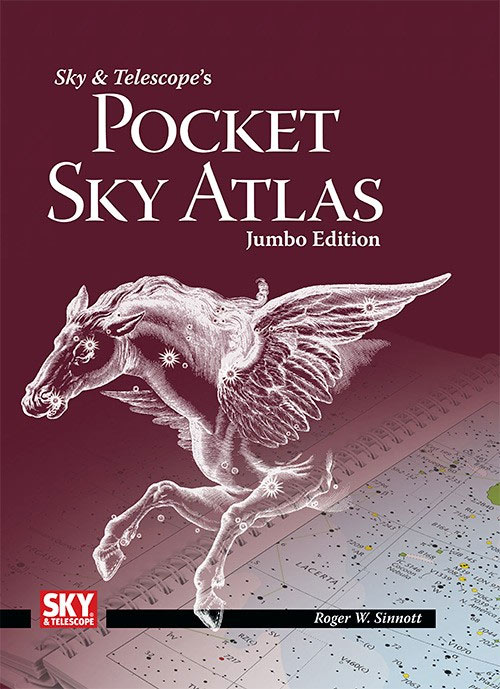Astronomy - This Week’s Sky at a Glance, October 7 – 15

Can you see Jupiter yet vert low in the dawn under Mercury?

Jupiter and Mercury are in conjunction Tuesday morning. (The difference in their brightnesses will be more obvious than shown here.)
Friday, October 7
• The Moon hangs in the south-southwest at dusk. To its lower left shines Mars, orange-yellow. Last night Mars was just 0.2° from the fainter star Lambda Sagittarii (magnitude 2.8). Now Mars is 0.6° to the star's left.
Saturday, October 8
• First-quarter Moon (exact at 12:33 a.m. tonight EDT). This evening the Moon is far below 1st-magnitude Altair and above Mars and the tilting Sagittarius Teapot. Mars, traveling eastward fast, is now 1.3° to the left of Lambda Sagittarii.
Sunday, October 9
• Soon after dark, you'll find zero-magnitude Arcturus low in the west-northwest at the same height as zero-magnitude Capella in the northeast. When this happens, turn to the south-southeast, and there will be 1st-magnitude Fomalhaut at the same height too — if you're at latitude 43° north. Seen from south of that latitude, Fomalhaut will appear higher; from north of there it will be lower.
Monday, October 10
• Jupiter and fainter Mercury have a close conjunction on Tuesday morning the 11th. Look low due east about 45 minutes before your local sunrise time. They'll be 0.8° apart at the times of dawn for North America, with Mercury to Jupiter's left.
Tuesday, October 11
• Vega is the brightest star very high in the west at nightfall. Arcturus, equally bright, is getting low in the west-northwest. The brightest star in the vast expanse between them, about a third of the way from Arcturus back up toward Vega, is Alphecca, magnitude 2.2 — the crown jewel of Corona Borealis. Alphecca is a 17-day eclipsing binary, but its brightness dips are too slight for the eye to see reliably.
Wednesday, October 12
• As evening grows late, look 20° below the Moon — about two fists at arm's length — for Fomalhaut: the "Autumn Star" and the bright mouth of faint Piscis Austrinus, the Southern Fish (no relation to Pisces).

Saturn and Antares advance closer to bright Venus this week.
Thursday, October 13
• The gibbous Moon lights the southeastern sky after dark. Look upper left of it, by a couple of fists at arm's length, for the Great Square of Pegasus tilted up onto one corner. Far lower right of the Moon is 1st-magnitude Fomalhaut.
• Algol should be at minimum brightness, magnitude 3.4 instead of its usual 2.1, for roughly two hours tonight centered on 1:00 a.m. EDT; 10:00 p.m. PDT. At any randomtime you glance up at Algol, you have a 1-in-30 chance of catching it at least 1 magnitude fainter than normal.
Friday, October 14
• This is the time of year when the Big Dipper lies level in the north-northwest in mid-evening. Look two fists at arm's length above it for Kochab, the brightest star in the bowl of the Little Dipper.
Saturday, October 15
• Full Moon (exact at 12:23 a.m. EDT tonight). The Moon rises around sunset due east. After dark, look almost 20° left of the Moon for the brightest stars of Aries.
_________________________
Want to become a better astronomer? Learn your way around the constellations! They're the key to locating everything fainter and deeper to hunt with binoculars or a telescope.
This is an outdoor nature hobby. For an easy-to-use constellation guide covering the whole evening sky, use the big monthly map in the center of each issue of Sky & Telescope, the essential guide to astronomy.

The Pocket Sky Atlas plots 30,796 stars to magnitude 7.6 — which may sound like a lot, but it's less than one per square degree on the sky. Also plotted are many hundreds of telescopic galaxies, star clusters, and nebulae. Shown above is the new Jumbo Edition for easier reading in the night. Click image for larger view.
Once you get a telescope, to put it to good use you'll need a detailed, large-scale sky atlas (set of charts). The basic standard is the Pocket Sky Atlas (in either theoriginal or new Jumbo Edition), which shows stars to magnitude 7.6.
Next up is the larger and deeper Sky Atlas 2000.0, plotting stars to magnitude 8.5, nearly three times as many. The next up, once you know your way around, is the even larger Uranometria 2000.0 (stars to magnitude 9.75). And read how to use sky charts with a telescope.
You'll also want a good deep-sky guidebook, such as Sue French's Deep-Sky Wonders collection (which includes its own charts), Sky Atlas 2000.0 Companion by Strong and Sinnott, or the bigger Night Sky Observer's Guide by Kepple and Sanner.
Can a computerized telescope replace charts? Not for beginners, I don't think, and not on mounts and tripods that are less than top-quality mechanically (meaning heavy and expensive). And as Terence Dickinson and Alan Dyer say in their Backyard Astronomer's Guide, "A full appreciation of the universe cannot come without developing the skills to find things in the sky and understanding how the sky works. This knowledge comes only by spending time under the stars with star maps in hand."
This Week's Planet Roundup
Mercury (magnitude –1.0) is the "star" very low due east in early dawn. Look about 40 minutes before your local sunrise time. It's sinking lower this week, but it remains bright.
Venus (magnitude –3.9) is low in the west-southwest in twilight. It's easily visible by 30 minutes after sunset.
Mars (magnitude +0.1) still shines in the south-southwest at dusk, just above the Sagittarius Teapot. In a telescope, Mars has shrunk to 8 arcseconds in diameter.
Jupiter (magnitude –1.7) is low in the dawn, in the company of Mercury. On the morning of October 7th Jupiter is 6° below Mercury and perhaps still invisible despite its greater brightness. But Jupiter is rising day by day, while Mercury is sinking. On the morning of the 11th they have a close conjunction, 0.8° apart, with brighter Jupiter on the right. By the 14th, Jupiter stands 5° to the upper right of Mercury.
Saturn (magnitude +0.5) shines in the southwest as twilight fades. Its distance upper left from Venus shrinks from 25° to 18° this week, while its distance lower right of Mars expands from 25° to 30°. Look for Antares (magnitude +1.0) twinkling 6° below Saturn.
Uranus (magnitude 5.7, in Pisces) and Neptune(magnitude 7.8, in Aquarius) are fairly well up after dark in the east and southeast, respectively. Info and finder charts.
__________________________
All descriptions that relate to your horizon — including the words up, down, right, and left — are written for the world's mid-northern latitudes. Descriptions that also depend on longitude (mainly Moon positions) are for North America.
Eastern Daylight Time (EDT) is Universal Time (UT, UTC, or GMT) minus 4 hours.
__________________________
"This adventure is made possible by generations of searchers strictly adhering to a simple set of rules. Test ideas by experiments and observations. Build on those ideas that pass the test. Reject the ones that fail. Follow the evidence wherever it leads, and question everything. Accept these terms, and the cosmos is yours."
— Neil deGrasse Tyson
— Neil deGrasse Tyson
No comments:
Post a Comment